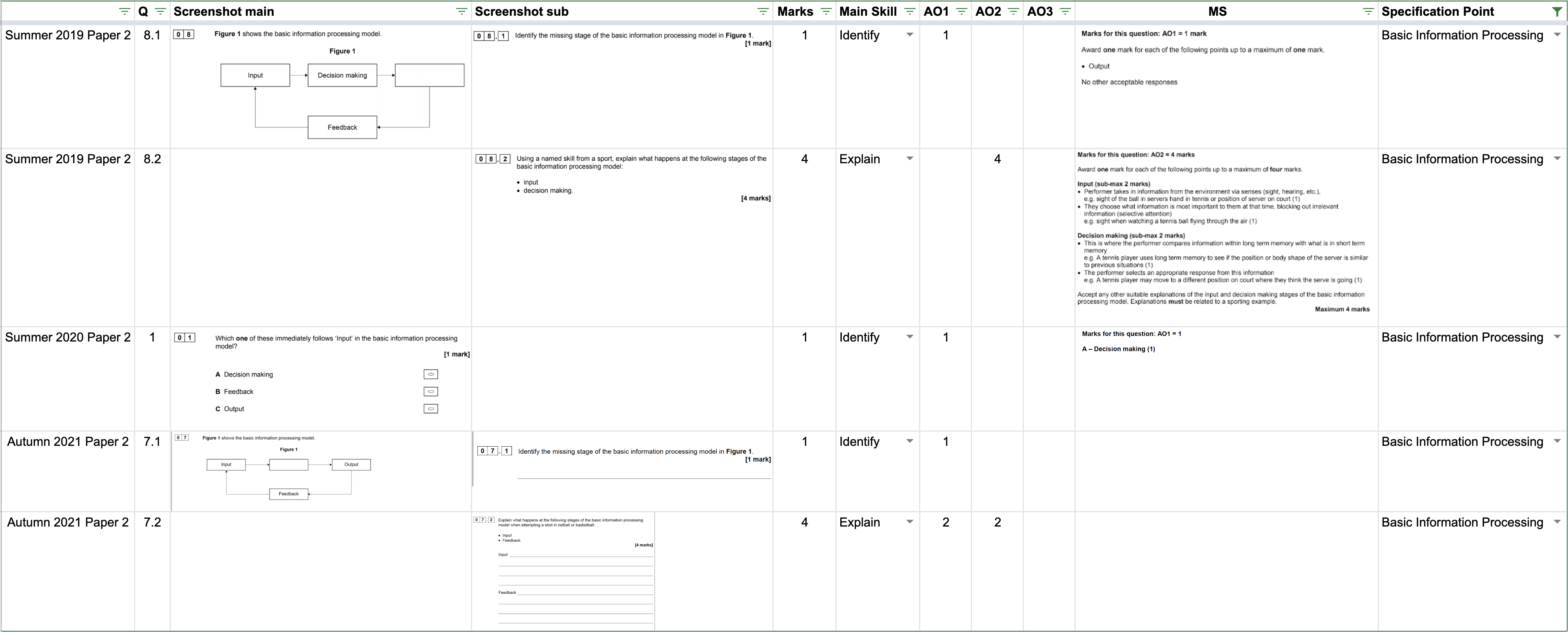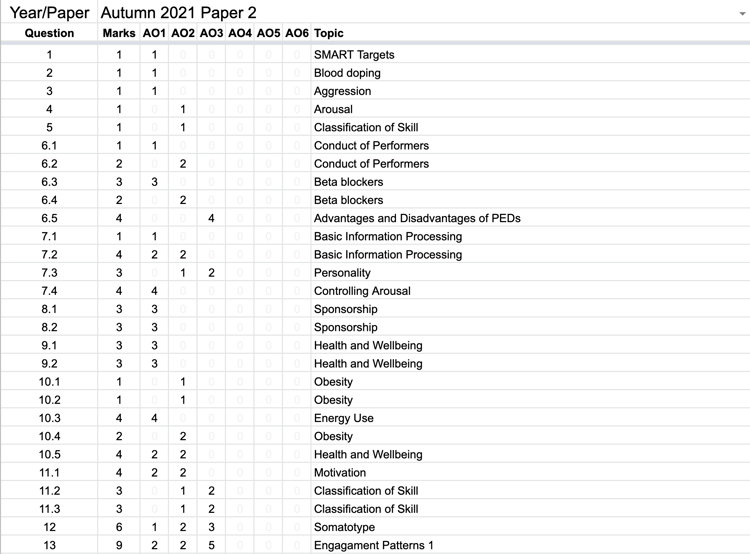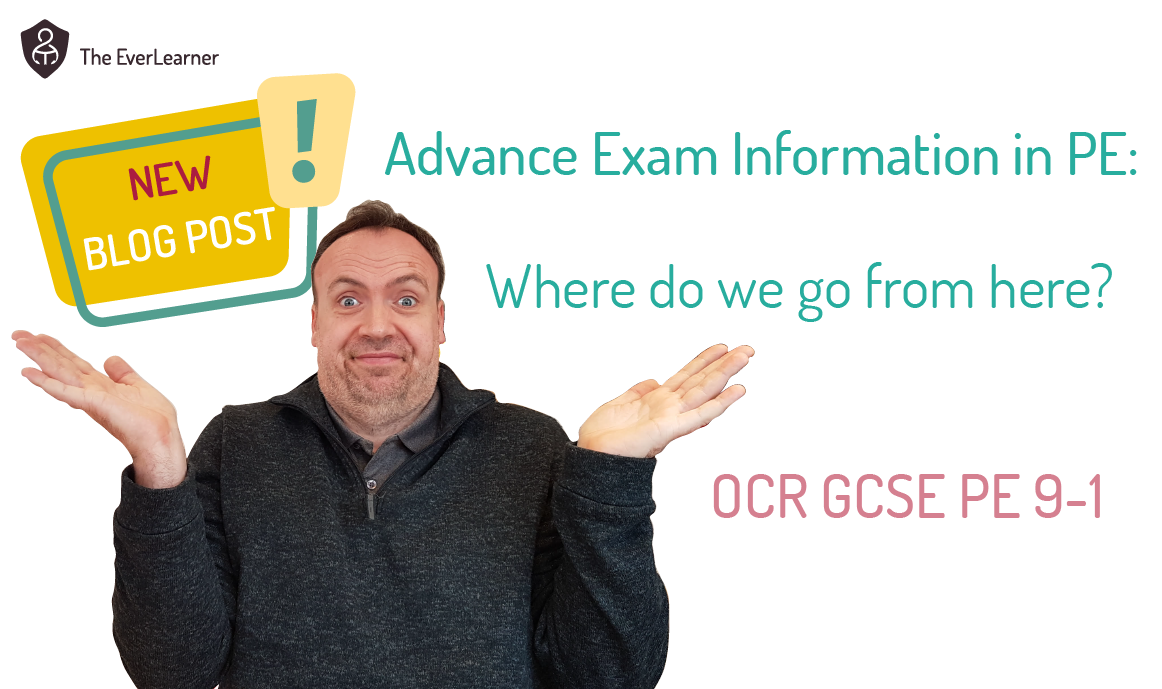How to write mock exam papers in PE
With Advanced Exam Information published and available (see links below), there will be a clamour by PE teachers to formulate the most relevant practice exam experiences for their students. These experiences may take the form of mock exams but may also be shorter, more focussed papers or mini-tests. Whichever it is for you, I want to recommend some overarching principles that guide good exam experiences in academic PE.
↪️ Switch to AEI guidance AQA GCSE PE
↪️ Switch to AEI guidance Edexcel GCSE PE
↪️ Switch to AEI guidance OCR GCSE PE
↪️ Switch to AEI guidance AQA A-level PE
↪️ Switch to AEI guidance OCR A-level PE
↪️ Switch to AEI guidance on how to analyse exam papers
↪️ Switch to read about my May 2022 live revision sessions
↪️ Switch to download your own copy of the exam infographics
When providing an exam experience to students, teachers must ensure that:
- the exam experiences are time-restricted;
- no matter how long or short the paper is, the exam experiences are taken under general exam conditions;
- no matter how long or short the paper is, the exact marks-per-minute ratio is applied;
- all exam experiences generate a diagnostic;
- all exam experiences are available for repetition by students if they choose to do so; and
- all exam experiences have extra time available for students with access arrangements.
Anything short of what is written above is not an exam experience. For example, it is perfectly legitimate to set a past-paper question without time limits but this is not an exam experience. It is a classroom or homework experience, nothing more. Exam experiences are defined by the points above. It is worth adding at this point that the vast majority of PE courses that I have had exposure to undercook their students with regards to these exam experiences. Students will frequently receive a PowerPoint but will infrequently be challenged to write under time-restricted conditions. Why? I believe the answer to this is that time-restricted exam experiences feel like tests, not like learning. This is true if the exam does not produce diagnostic data. If the exam experience does produce diagnostic data, the exam experience is a highly relevant exam experience.
The following diagnostic example comes from an exam taken on ExamSimulator via TheEverLearner.com:
Whilst on a blog post I do not specifically want to promote my own software (ExamSimulator) and content, I do want to emphasise the type of support that thousands of students are receiving but too many others are not. If you are unsure about the implementation of this at such a busy time, please book a training session with me here and I'll ensure you have all the information you need.
So, let’s assume that you want to set an AQA GCSE PE paper for your students and you want to focus the paper on the basic information processing section of Paper 2. Your options might be:
- Cut and paste some past paper questions.
- Use ExamPro or equivalent.
- Search TES for example questions.
- Use ExamSimulator.
Clearly, I am biased towards ExamSimulator but it is not biased to say that all of the options above can give you access to some relevant content. The problem is that we have not yet established which skills need testing in your exam experience.
This is a classic error: we set up our exam to measure content. We shouldn’t. Our exam experiences should use content to develop exam skills such as explaining or describing or evaluating or, typically, a range of these skills.
Therefore, we must first analyse what types of skills are expected by students in this area of knowledge. We can only do this by analysis of previous papers.
Take this example of basic information processing on the AQA GCSE PE 9-1 course for Paper 2.
 Image taken from TheEverLearner exam paper analysis documents
Image taken from TheEverLearner exam paper analysis documents
It is clear to see that the required skills come from “Identify/State/Give” and “Explain” and that the mark range is likely to be between two and four marks. We now have clear parameters by which to write or select an appropriate exam experience. This causes our exam experience to be a form of “near transfer”. In other words, students are practising like the real thing. Once this analysis is done, the teacher has the following options:
- Set questions exactly like they have been in the past. In this case, 2-4 mark questions using the identify and explain skills.
- Set most of the questions like they have been in the past but challenge the future by including a range of one-markers and potentially even a six-marker.
I strongly advocate for option 2 because this future-proofs your learners and ensures that they are not “past-paper robots”.
Let’s take things further. Let’s imagine that we want to write an entire AQA GCSE PE Paper 2 mock exam. The only way to do this is to have a clear picture of, at the very least, the last iteration by AQA in 2021. The image below shows exactly how that paper was structured and this structure can be mimicked, with different content (likely the AEI content).

We now know that our mock exam experience should follow this model in terms of question structure and order (not content which we will change). We can also be certain that our assessment objective distribution will be accurate and provide the relevant challenge. This is extremely important. Teachers should not be concerned that a small exam experience is not assessment-objective-representative but mock exam experiences definitely should be. In most cases, this will result in a teacher selecting a whole past paper and setting it in its entirety. I strongly recommend this practice is avoided for the reasons provided previously.
I want to make an important point here: what I am describing to you has impact. You may be reading it and thinking to yourself: “It’s pretty specific” or “there’s work to do” but this work causes impact. In other words, it is a valuable use of your time. As a teacher for twenty years, I often felt that the majority of my work could not be described in this way. Well, this effort will have an impact and it is likely that you will approach it with energy and belief. Furthermore, the model of how to do it is set out in this blog for you to follow as well as our infographics which you can download here.
I am going to end this post with a few challenging questions for teachers to ponder. Please accept there are no firm right and wrong answers and the questions are intended to challenge and provoke:
✅ During your course, are exam experiences genuinely representative of “the real thing”?
✅ During your course, do students have time-restricted exam experiences commonly?
✅ During your course, do all exam experiences produce diagnostic data?
✅ During your course, are exam experiences primarily used for assessment or primarily used for learning?
✅ During your course, do you apply exam experiences focussed on skills (describe, explain, evaluate, say) or do you apply them with content in mind?
✅ During your course, do all exam experiences have the relevant marks-per-minute ratio applied?
✅ During your course, do all exam experiences honour students that receive extra time in the summer exam?
Thank you for reading.
%20Text%20(Violet).png)











